An In-Depth Look at Eligibility for Medicaid Waiver Programs
Medicaid waiver programs serve as a vital resource for individuals requiring long-term care and support, enabling them to remain in their homes or community settings rather than institutional facilities. These programs, authorized under federal law, provide personalized services to various populations including the elderly, disabled, and those with complex medical conditions. Understanding the eligibility criteria—spanning financial, functional, health, and residence requirements—is essential for prospective applicants, caregivers, and advocates. This comprehensive guide explores the different types of Medicaid waivers, their specific qualification standards, application procedures, and how individuals can determine their eligibility to access these life-enhancing benefits.
Types and Goals of Medicaid Waivers
Medicaid offers a variety of waiver programs tailored to meet the long-term care needs of different populations, emphasizing community-based care over traditional institutional settings. Among these, the most common are the Home and Community-Based Services (HCBS) waivers authorized under Section 1915(c). These waivers allow states to provide personalized services such as personal care, home modifications, transportation, adult day care, and respite services to individuals with disabilities, seniors, and medically fragile populations.
In addition to the HCBS waivers, there are other types like Section 1915(b) waivers, which facilitate care through managed care organizations, offering flexibility in service delivery while maintaining federal compliance. The Section 1115 waivers serve as demonstration or pilot programs, enabling states to test innovative approaches to Medicaid delivery and financing.
The primary goal of these waivers is to help individuals live independently in their communities. They aim to reduce reliance on costly institutional care, promote personal choice, and improve quality of life by providing tailored supports that meet each person's unique health and functional needs.
The populations targeted by these waivers broadly include the elderly, individuals with developmental disabilities, those with physical disabilities, and persons with complex medical conditions. Different waivers target specific groups based on age, diagnosis, and level of care requirements.
| Waiver Type | Main Purpose | Target Population | Qualification Criteria |
|---|---|---|---|
| HCBS (Section 1915(c)) | Offers community-based services | Disabled, elderly, medically fragile | Need for nursing home level care, diagnosis, financial eligibility |
| Section 1915(b) | Managed care and choice | Similar to HCBS but focuses on care delivery | Income and functional criteria, managed care enrollment |
| Section 1115 | Pilot programs | Varies by project | Flexibility in Medicaid rules, specific pilot objectives |
These waivers extend Medicaid’s reach, making long-term services more accessible and aligned with individual preferences, thus fostering independence and improving overall health outcomes.
Eligibility Criteria for Program Participation
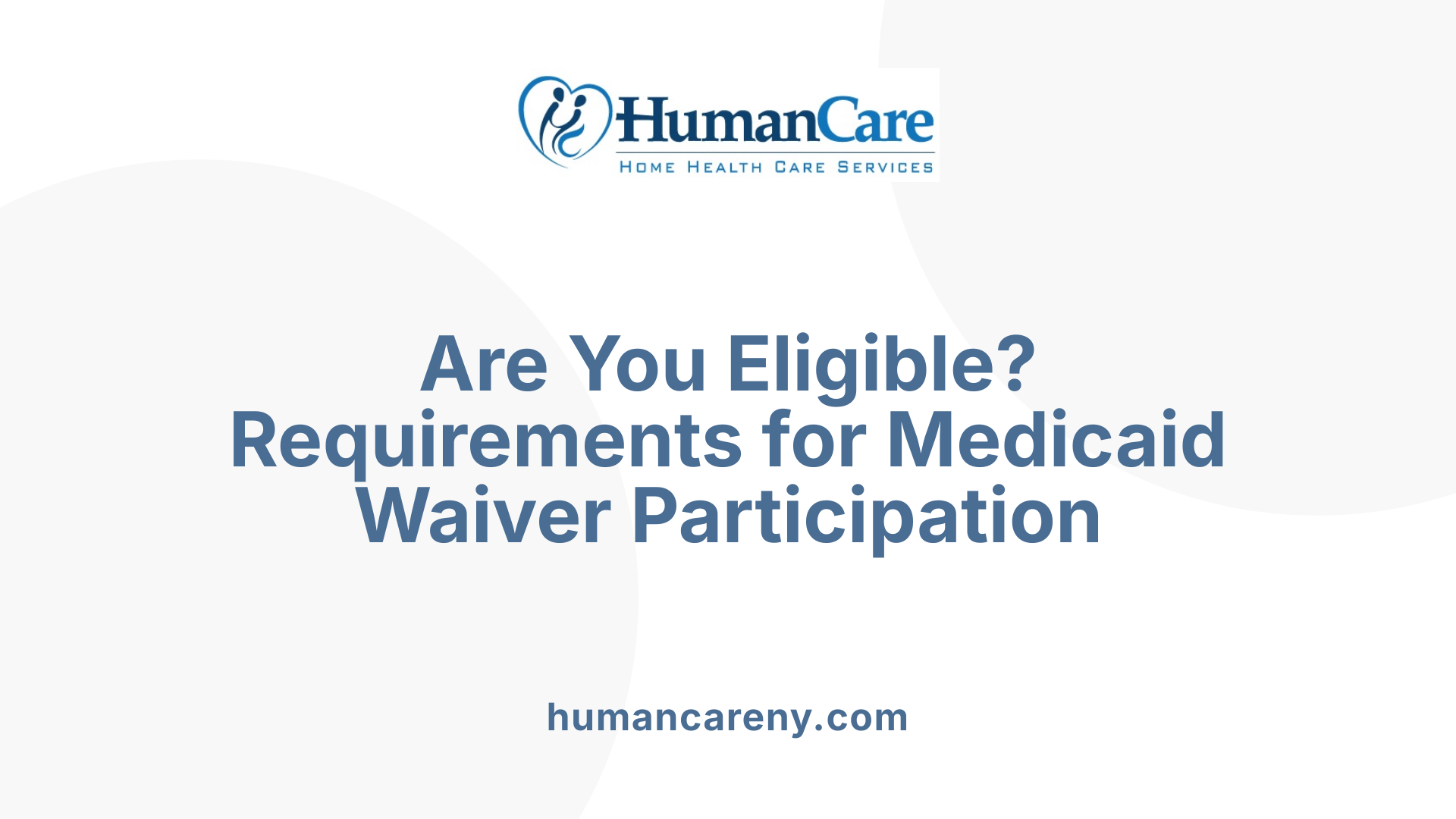
What are the eligibility criteria for Medicaid waiver programs?
Medicaid waiver programs are designed to help individuals live at home or in the community instead of in nursing facilities. To qualify, applicants must generally meet certain financial, residency, and health requirements.
First, candidates must be residents of the state offering the waiver program and qualify for Medicaid benefits. This typically involves meeting income and asset limits, which can vary by state but often align with federal poverty guidelines or Modified Adjusted Gross Income (MAGI) standards. For most programs, income limits are set at no more than 300% of the Federal Benefit Rate (FBR), and assets usually must not exceed $2,000, although some states allow higher limits or disregard certain assets.
Applicants must demonstrate a need for a level of care similar to that provided in nursing homes. This is assessed through medical evaluations, which identify substantial functional limitations in activities of daily living (ADLs) such as bathing, dressing, or medication management. Usually, a person must require assistance with at least three major ADLs or have complex medical needs.
Health conditions covered are diverse, including Alzheimer's disease, HIV, diabetes, cerebral palsy, autism, and traumatic injuries, among others. Age is also a factor; most waivers target seniors aged 65 and older, but many programs serve younger individuals with disabilities.
Additional eligibility considerations include U.S. citizenship or qualified non-citizen status and the application process, which involves initial assessment and sometimes a waiting period due to limited funding and capacity. The application also must be initiated through state Medicaid offices, often with a comprehensive evaluation confirming both functional and financial eligibility.
In summary, qualifying for Medicaid waivers involves a combination of financial need, medical necessity, residency, and citizenship status, tailored within each state’s specific guidelines to support individuals in community-based settings.
Financial and Functional Requirements
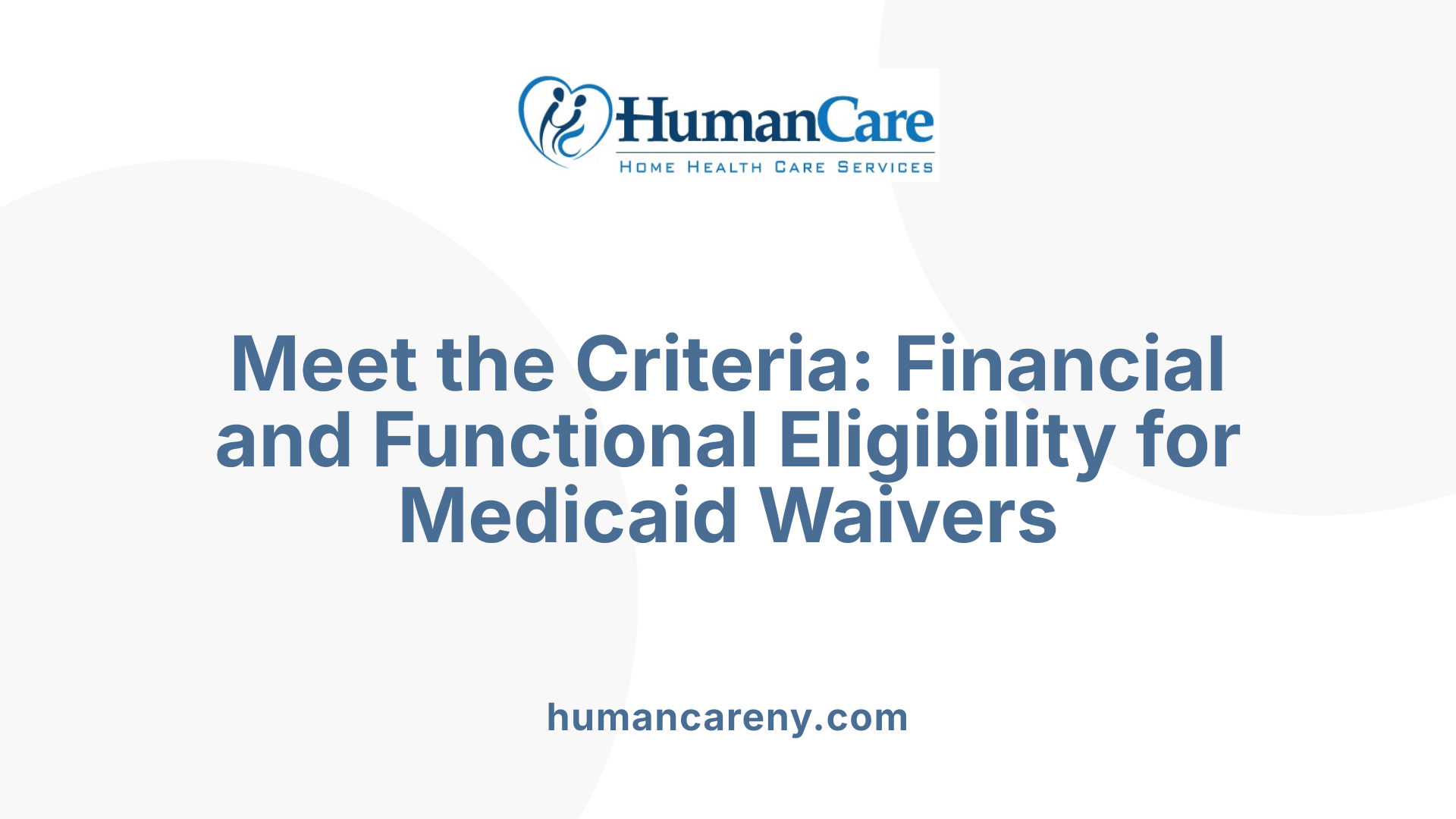 Eligibility for Medicaid waiver programs is determined by both financial and medical assessments, ensuring the right individuals receive community-based long-term care services.
Eligibility for Medicaid waiver programs is determined by both financial and medical assessments, ensuring the right individuals receive community-based long-term care services.
Financial criteria typically include income limits of up to 300% of the Federal Benefit Rate (FBR). For example, applicants must demonstrate income not exceeding this threshold to qualify. Asset limits are also in place, usually set at around $2,000, although some states may allow higher assets or disregard certain resources, such as primary residence or vehicle, during assessment.
For individuals with disabilities or those over 65, eligibility is often evaluated using methodologies similar to the Supplemental Security Income (SSI) program. This means certain income and resource exclusions apply, making it easier for qualifying individuals to meet financial standards.
On the functional side, applicants must show significant impairments that interfere with daily life activities. This is generally assessed through formal evaluations that measure the degree of difficulty in areas such as mobility, self-care, communication, and cognitive skills.
A critical requirement is a need for a level of care comparable to what is provided in a nursing home. This often involves a clinical assessment that determines the person’s necessity for around-the-clock support or extensive medical assistance.
These combined criteria ensure that community-based services are directed toward individuals with substantial needs who would otherwise require institutional care, promoting independence while managing healthcare costs.
| Criterion | Description | Typical Thresholds | Additional Notes |
|---|---|---|---|
| Income | Monthly income limit | Up to 300% of FBR | Varies by state and household size |
| Assets | Total resources available | Usually $2,000 | Can include savings, property, and personal belongings |
| Disability & Functional Limits | Impact on daily activities | Significant impairment in ≥3 areas | May include mobility, cognition, or communication |
| Level of Care | Medical necessity | Comparable to nursing home care | Requires assessment by qualified professionals |
Searching "Financial and functional criteria for Medicaid waivers" can provide additional in-depth information about specific state variations and detailed eligibility processes.
Application Process and Approval
What is the application process for Medicaid waivers?
Applying for Medicaid waivers involves several coordinated steps managed by state Medicaid agencies and local service providers. The first step is to submit an application for Medicaid benefits, which often requires providing detailed documentation of income, assets, health conditions, and residence status. This can typically be done online, by mail, or in person at designated offices.
Once Medicaid eligibility is established, applicants must then apply specifically for a waiver program, such as an HCBS waiver, through their state's Medicaid office. During this phase, an assessment process is conducted to evaluate the individual's medical and functional needs. Many states use standardized assessment tools like the interRAI to evaluate the level of care required.
This assessment helps determine if the applicant qualifies based on the need for institutional-level care and other criteria set by the state. The approval process may vary in length—from a few days to several months—particularly because many waiver programs have limited funding and therefore a waiting list.
Applicants are often able to monitor their application status through their state Medicaid portal or by contacting the relevant agency. Once approved, individuals can begin receiving services; however, some may need to undergo periodic reassessments or reapplications to maintain eligibility for the waiver.
Documentation and assessments required
Applicants need to provide comprehensive documentation, including proof of income and assets, residency, and medical conditions. Medical records and physician certifications may be necessary to demonstrate the need for a nursing facility level of care.
Assessment tools like the interRAI evaluate the individual's capabilities across multiple domains, such as activities of daily living, mobility, and health status. This evaluation ensures that waiver services align with the person's specific needs and that they meet the program's standards.
Waiting lists and reapplication procedures
Many waiver programs have waiting lists due to funding constraints. Being added to the list often doesn't require prior proof of eligibility—applicants are typically added based on the timing of their application. Once at the top of the list, they undergo an in-depth assessment to confirm continued eligibility.
If an individual is denied or placed on a waiting list, they can often reapply or update their application information. Regular re-evaluations are common to maintain the right to services and to adjust care plans as needed.
States may also have specific procedures for reapplication or priority re-assessment for certain populations, such as those with urgent needs or life-threatening conditions. It's important for applicants to stay in contact with the relevant agencies and keep their contact information current to avoid missing critical updates or opportunities for service.
More Information
For detailed guidance, search for "Medicaid waiver application procedures and assessment requirements" to access state-specific forms, assessment criteria, and appointment scheduling details.
Eligibility Based on Age, Residence, and Health
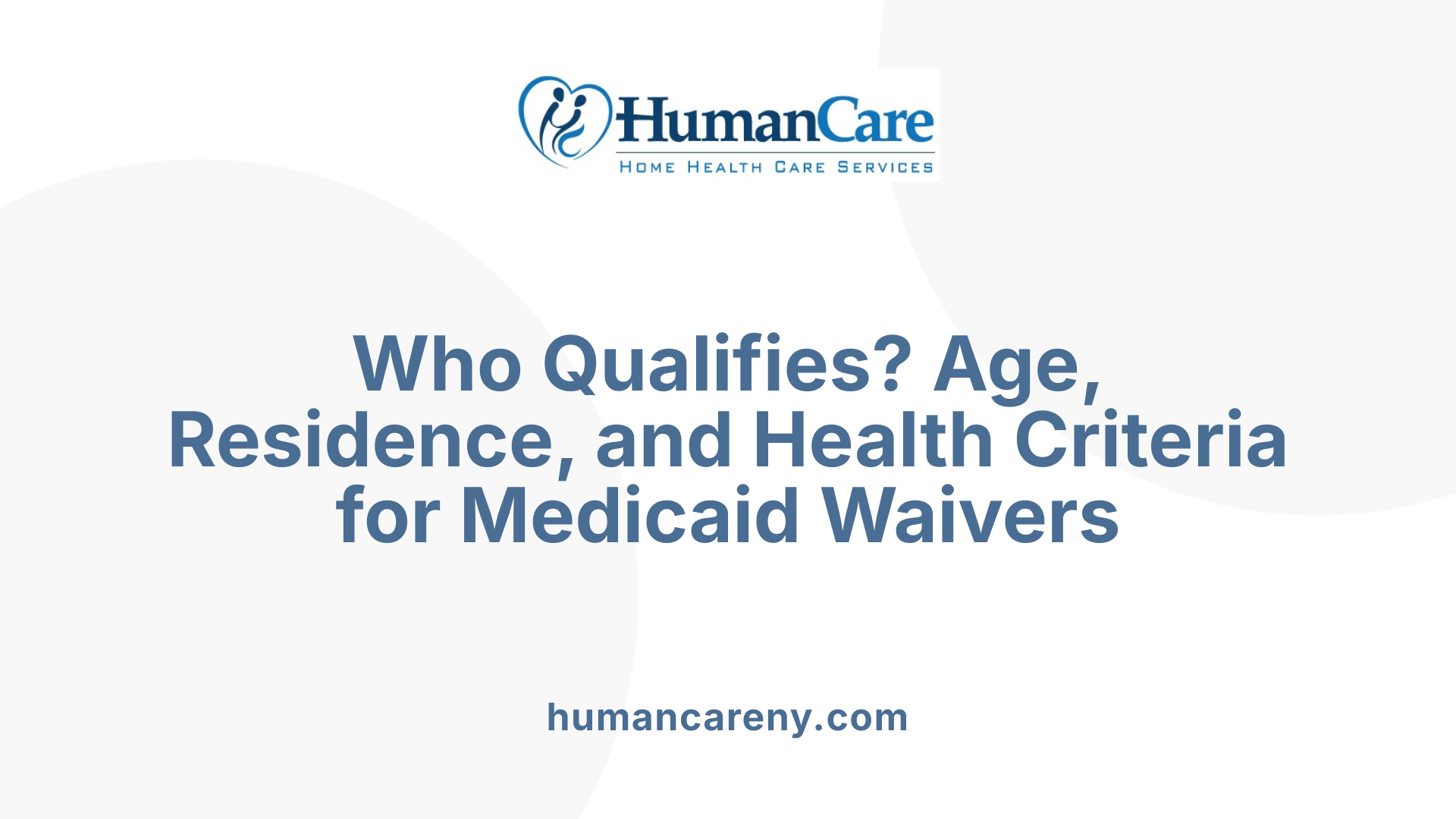
Are there age, residence, or health status qualifications for Medicaid waiver eligibility?
Yes, Medicaid waivers generally have specific criteria related to age, residence, and health status, though these can differ greatly depending on the program and state. Most programs target specific populations such as seniors aged 65 and older or individuals with disabilities. These disabilities may include physical impairments, intellectual disabilities, developmental disabilities, or chronic health conditions that require long-term care.
Residency is a common requirement, meaning applicants must live within the state offering the waiver. Some programs also accommodate individuals who are transitioning into eligible living arrangements or are in the process of establishing residence.
Health status qualifications focus on demonstrating a significant need for Medicaid-funded services. This typically involves a clinical assessment that confirms the individual requires a level of care similar to what is provided in a nursing home. Such assessments evaluate the person’s ability to perform Activities of Daily Living (ADLs) like bathing, dressing, eating, or medication management.
To qualify, applicants must generally have considerable functional limitations that necessitate assistance or supervision, alongside medical diagnoses that support their need for ongoing support services. The goal of these criteria is to identify individuals who would be at risk of institutionalization without the support provided by Medicaid waiver services.
Specialized and Targeted Waivers for Specific Conditions
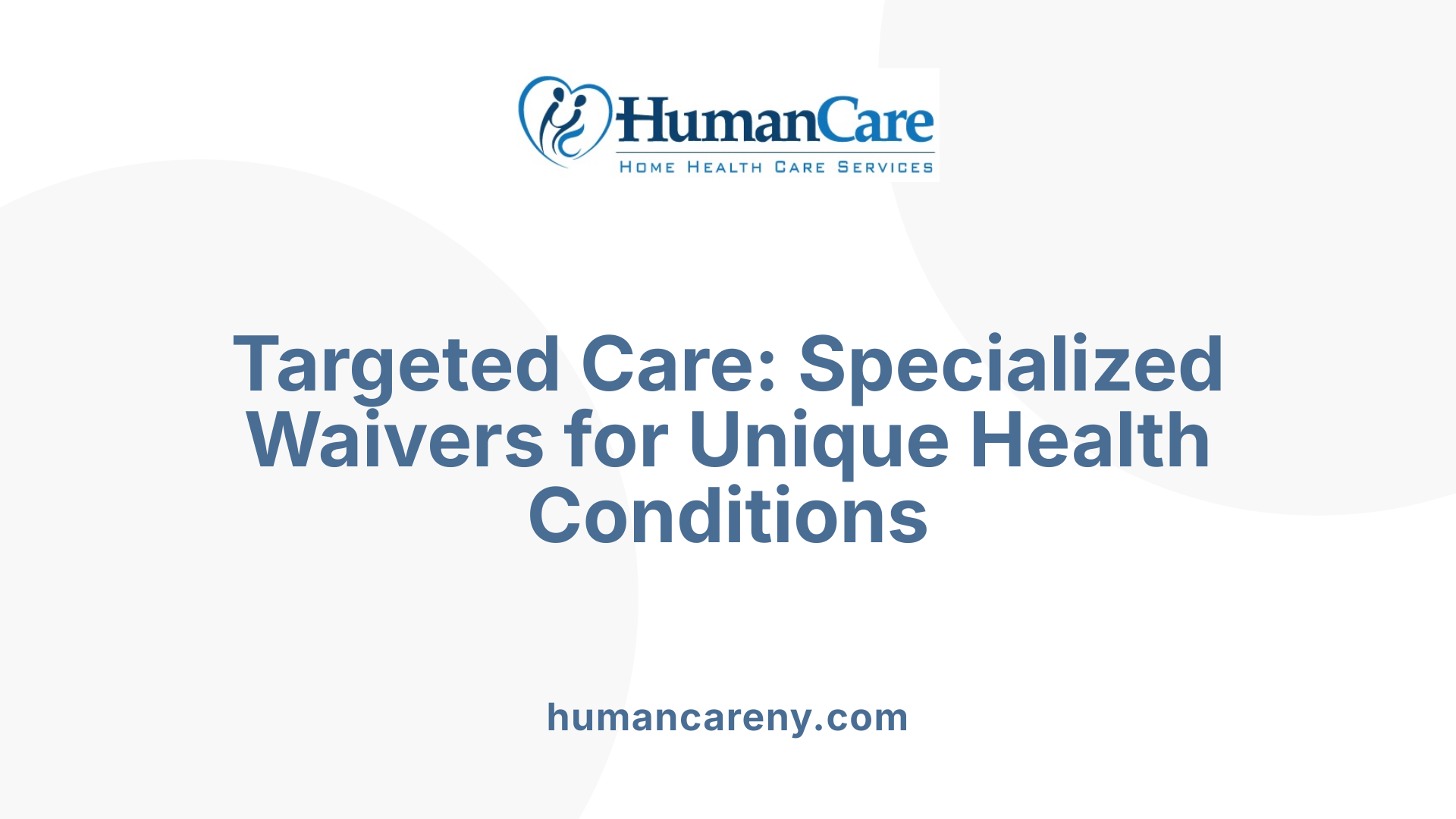
Who qualifies for a Medicaid waiver?
Qualification for Medicaid waivers largely depends on the individual’s health condition, care needs, and demographic factors. Different waiver types are tailored to specific populations and medical conditions, each with their own eligibility criteria.
For developmental disability waivers, such as those supporting individuals with autism or intellectual disabilities, applicants must have a diagnosed condition confirmed by a licensed psychologist or medical doctor. They must also demonstrate substantial limitations in conceptual, social, or practical skills, which significantly impact daily functioning.
Traumatic Brain Injury (TBI) waivers have specific requirements. Applicants need to be at least 18 years old, have a verified diagnosis of traumatic brain injury, and require nursing facility level of care. This involves ongoing medical monitoring and assistance with daily activities due to brain injury-related impairments.
Target populations for these condition-specific waivers include children and adults with developmental disabilities, individuals recovering from TBI, and the elderly or physically disabled who need support to live independently in community settings.
Criteria often include detailed assessments to verify the medical diagnosis, evaluate the level of care needed, and confirm the individual’s ability to live outside institutional facilities. This ensures that resources are directed toward those with genuine needs and that services are appropriately tailored.
Overall, each waiver program has specific requirements designed to serve individuals effectively based on their health status, functional limitations, and care needs, aiming to support their independence and improve quality of life.
What are the population and condition-specific eligibility criteria?
| Waiver Type | Population Focus | Medical/Functional Criteria | Additional Notes |
|---|---|---|---|
| Developmental Disabilities Waivers | Individuals with autism or intellectual disabilities | Diagnosis by licensed professional, IQ of 70 or below, adaptive skill deficits | Must demonstrate substantial limitations in daily skills |
| Traumatic Brain Injury (TBI) Waivers | Individuals 18+ with TBI | Confirmed TBI diagnosis, need for nursing care | Requires assessment of injury severity and care needs |
| Elderly and Disabled Waivers | Seniors 65+, or those with physical disabilities | Need for assistance with daily activities, Level of Care assessment | Supports aging in place and community living |
These carefully structured criteria help ensure that the limited resources allocated through Medicaid waivers reach individuals with the most essential needs, facilitating their ability to live in their homes and communities instead of institutions.
Continuity, Renewal, and Support in Waiver Programs
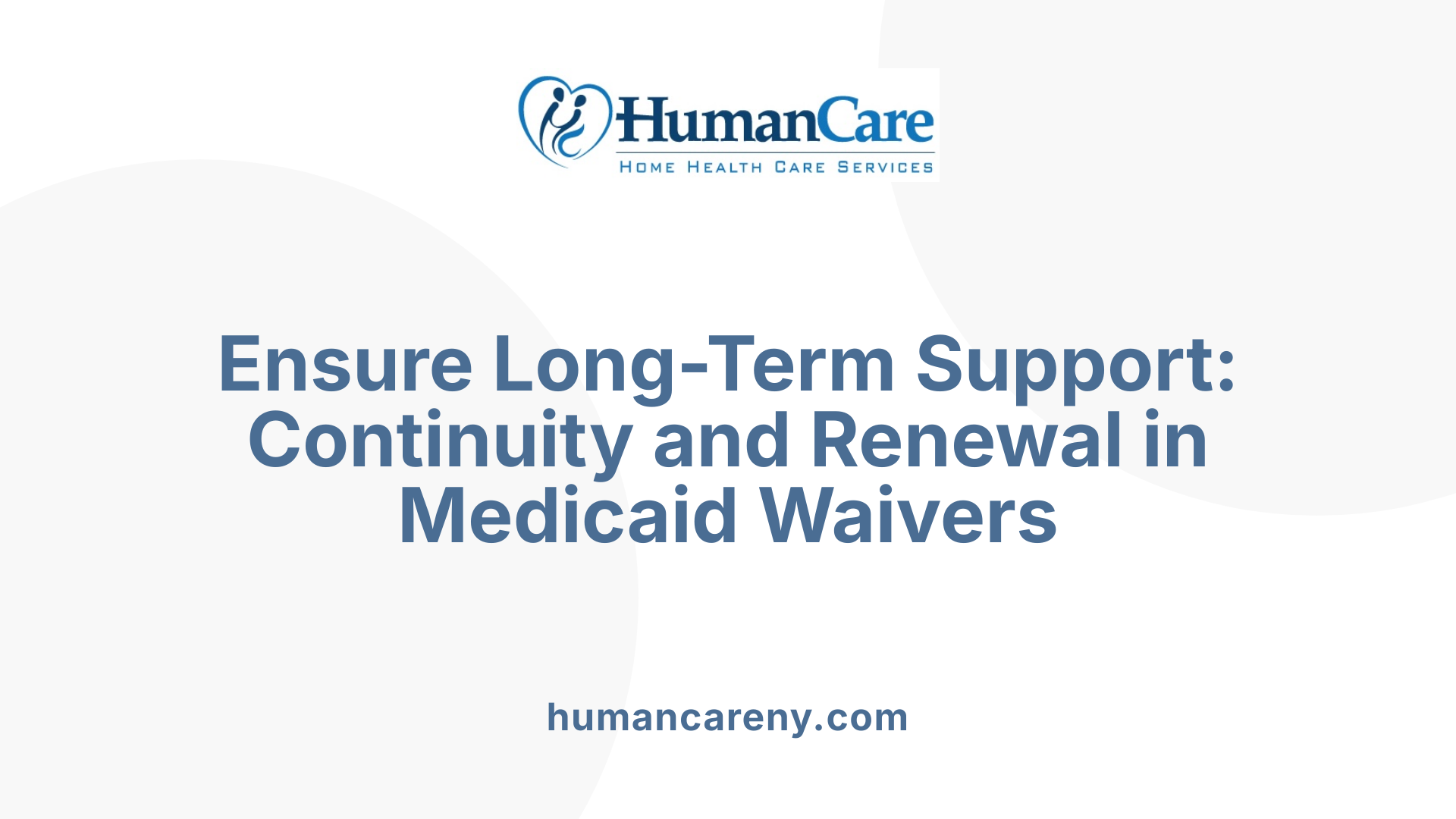
How does one qualify for a Medicaid waiver?
Qualifying for a Medicaid waiver involves meeting several criteria related to health, functional abilities, and financial status, all of which are specific to each program and state. Applicants must demonstrate a need for community-based services, often through an assessment that shows they require a level of care similar to that provided in a nursing home.
Most applicants need to already be eligible for Medicaid, which requires meeting income and asset limits, and they must reside in the state where the waiver is offered.
The application process typically involves filling out forms, submitting necessary documentation, and participating in evaluations conducted by state or local agencies. For example, assessments of medical condition, functional limitations, and care needs are standard.
Once approved, individuals are required to maintain eligibility through periodic re-evaluations. These re-assessments help confirm that participants continue to meet the criteria for program participation.
Medicaid waivers often operate on a five-year cycle, meaning the program’s authority is authorized for five years before renewal is necessary. Program providers or participants may need to reapply or update their information to demonstrate ongoing need.
Renewal processes require renewal applications and supporting documentation, which are reviewed by state agencies to determine continued eligibility. It is essential for participants to keep contact information current and fulfill all re-evaluation requirements to avoid losing benefits.
This cycle of evaluation and renewal ensures that resources are directed toward individuals with the greatest needs, while also allowing programs to adapt to changing health and social circumstances of participants.
In summary, maintaining eligibility for Medicaid waivers involves initial qualification through health and financial assessments, followed by ongoing re-evaluations to sustain support within the program’s lifecycle, generally lasting up to five years.
Empowering Informed Choices for Long-Term Care
Understanding the eligibility criteria for Medicaid waiver programs is essential for individuals seeking alternatives to institutional care. By grasping the nuances around financial, functional, health, and residence requirements—as well as the application procedures—applicants can better navigate the process and access personalized, community-based support services. These programs are designed to accommodate diverse needs and conditions, emphasizing independence and quality of life. Stakeholders are encouraged to engage with local Medicaid offices, assess their eligibility thoroughly, and stay informed about renewal requirements and program updates. With comprehensive knowledge, individuals can make empowered choices towards maintaining autonomy in their living arrangements and health care.
References
- Do I Qualify for a Medicaid Waiver Program? - Healthline
- Home & Community-Based Services 1915(c) - Medicaid
- Aged and Disabled Waiver - Indiana Medicaid for Members - IN.gov
- Medicaid Waivers & How They Help Seniors Live at Home
- [PDF] Understanding Medicaid Home and Community Based Waivers for ...
- Indiana's Medicaid Waiver Programs: Home and Community-Based ...
- State Medicaid Plans and Waivers - CMS
- Eligibility Policy | Medicaid



